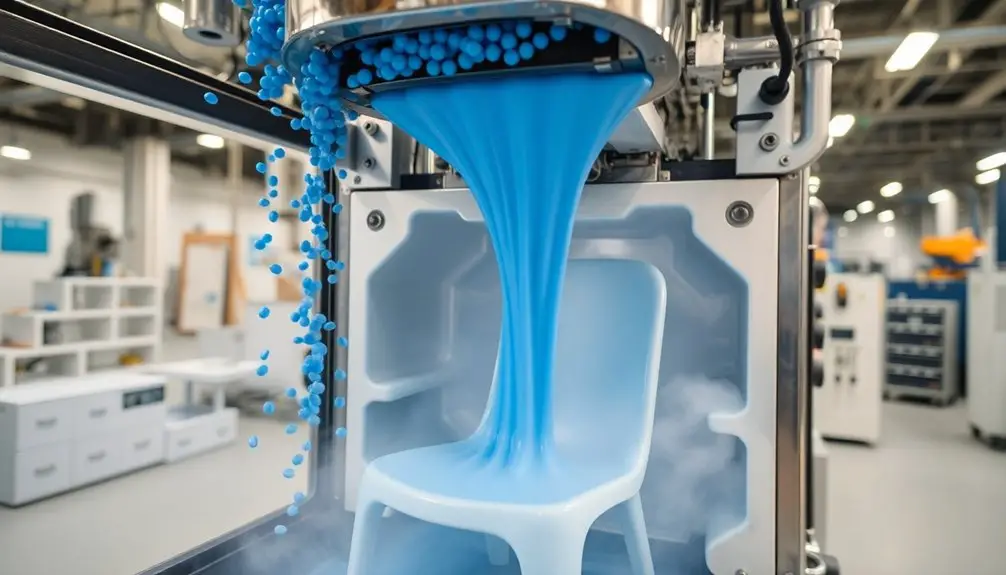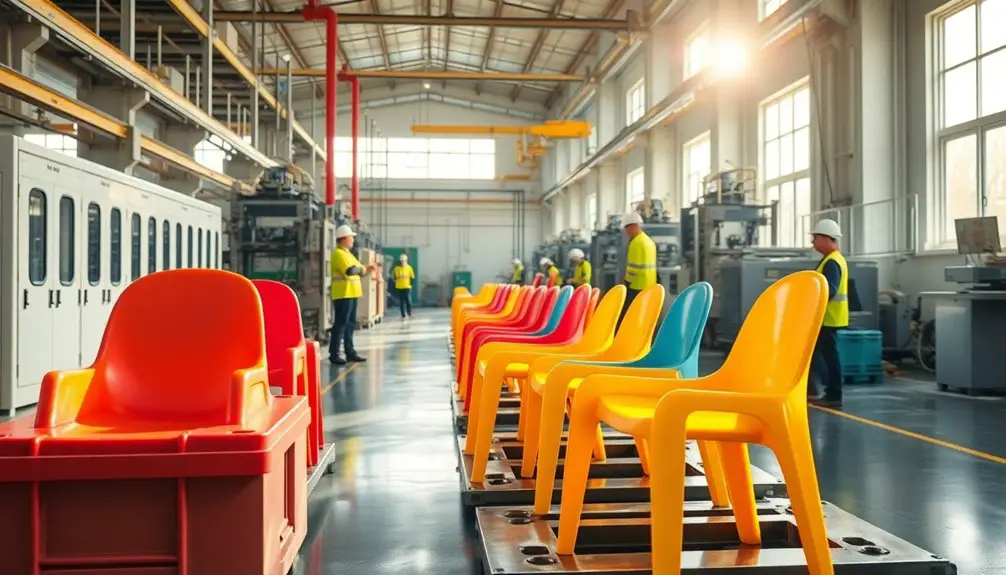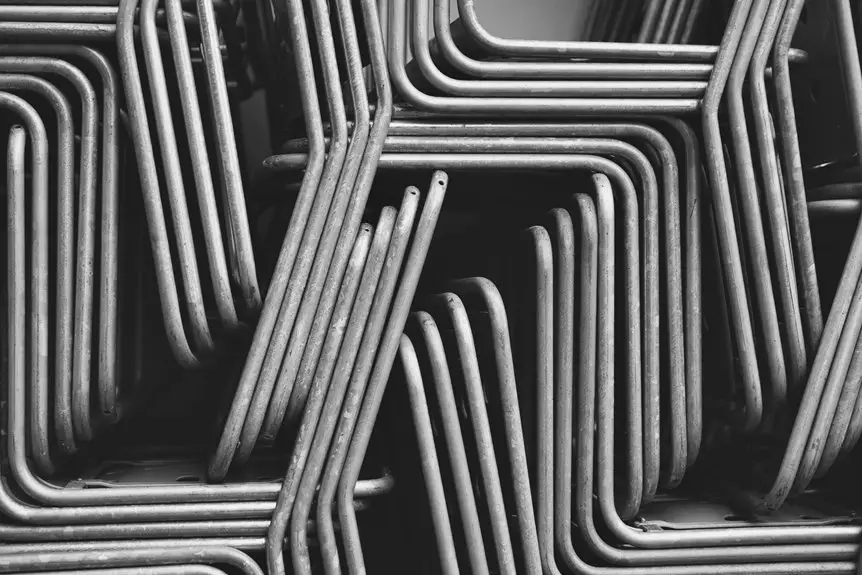To make polypropylene chairs, manufacturers primarily use injection molding. You start by heating polypropylene granules until they melt. Once molten, the plastic is injected into specially designed molds, shaping it into your chair. The quality of the mold plays a vital role in the final product's strength and appearance. After cooling, the chair solidifies and undergoes quality control checks to ensure it meets required specifications. This process not only provides durability but also allows for innovative designs. Curious about the intricacies and advancements in chair production? You're in for a treat as there's plenty more to explore!
Key Takeaways
- Polypropylene chairs are primarily made using injection molding, where heated granules are injected into molds to form the chair shape.
- The quality of the mold design significantly affects the final product, making precise mold design crucial for strength and uniformity.
- During the cooling phase, solidification of the molten polypropylene ensures dimensional accuracy and maintains the desired chair specifications.
- Gas-assisted injection molding techniques are often used to create lightweight and hollow chair designs, enhancing durability.
- Quality control measures, including inspections and dimensional accuracy checks, ensure that the finished chairs meet performance standards.
Overview of Polypropylene
When it comes to versatile materials, polypropylene (PP) stands out for its lightweight and durable nature. This low-density thermoplastic is manufactured from the polymerization of propylene gas, making it one of the most popular plastics in the world, second only to polyethylene.
You'll appreciate its high chemical resistance and low moisture absorption, which allow for a wide range of applications, from packaging to automotive parts and even medical devices.
One of the key advantages of polypropylene is its impressive melting point of around 160°C, making it heat-resistant and ideal for products that demand both durability and flexibility.
You'll find that its properties enable it to withstand harsh conditions, enhancing product longevity. Moreover, polypropylene can be recycled and falls under recycling code #5, although its recycling rate isn't as high as some other plastics. Polypropylene shares similarities with polyethylene, particularly in terms of applications, as both High-Density Polyethylene (HDPE) types are widely used in manufacturing.
Key Manufacturing Processes
The key manufacturing process for polypropylene chairs is injection molding, a technique that efficiently transforms polypropylene granules into durable and intricate designs. This process starts with heating the granules until they reach a molten state. The molten plastic is then injected into a precisely designed mold, which plays a crucial role in the final product's quality.
In this manufacturing process, several factors contribute to the successful production of polypropylene chairs:
- Consistent wall thickness is essential for uniformity and strength.
- Precise mold design accounts for over 80% of the mold's quality.
- Mass production enhances cost efficiency by reducing per-unit costs.
Once the mold is filled, compressed air jets ensure the molten plastic is evenly distributed, followed by a cooling phase that solidifies the chair design. This method not only allows for complex shapes but also supports high production volumes, similar to those of PVC manufacturing processes used for durable, chemical-resistant piping.
Injection Molding Techniques

In the world of polypropylene chair manufacturing, injection molding techniques play a pivotal role in achieving efficiency and precision. This primary manufacturing method involves heating polypropylene granules until they reach a molten state. You then inject this material into precisely designed molds, which is crucial to the overall quality of the chair. The mold design accounts for over 80% of the quality, so you must carefully consider wall thickness and geometry to ensure optimal flow and cooling. During the injection molding process, compressed air jets help distribute the molten polypropylene evenly against the mold walls, ensuring a consistent chair shape and structure. Once injected, cooling is critical; it solidifies the polypropylene and directly impacts the final product's dimensional accuracy and finish quality. For more complex chair designs, gas-assisted injection molding can be employed. This technique allows for hollow sections in the chairs, resulting in lighter products without sacrificing strength. Additionally, the use of polypropylene and low maintenance materials in chair manufacturing enables the creation of durable products that are easy to care for and maintain.
Quality Control Measures
Implementing effective quality control measures is vital in the manufacturing of polypropylene chairs to ensure each product meets high standards. Throughout the production process, rigorous inspections play a crucial role in assessing consistency and performance. This ensures that every chair adheres to design specifications and upholds product quality.
Key aspects of quality control include:
- Mold testing: Verifying mold design suitability is essential for predicting injection molding outcomes and maintaining product quality.
- Dimensional accuracy checks: Final products undergo comprehensive inspections to ensure they meet specified measurements and structural integrity.
- DUPRO reports: These reports document quality concerns during production, helping to identify and rectify faults early, thereby reducing waste.
Regular assessments of mold design and material properties are necessary to maintain the chairs' high quality. If inspection results indicate any issues, adjustments are made promptly. Furthermore, manufacturers must also consider the environmental impact by incorporating eco-friendly materials into their production process to minimize waste and promote sustainability.
Business Opportunities in Production

Exploring business opportunities in polypropylene chair production can lead to significant growth and innovation in the furniture market. By partnering with experienced injection molding manufacturers, you can access high-quality production capabilities and enhance your business's potential.
The manufacture of plastic chairs allows you to engage in short-run productions, which can be beneficial for testing new designs or limited editions. Collaborating with certified manufacturers ensures the quality you'll be investing in meets industry standards, vital for building a reputable brand.
Additionally, engaging in mentorship programs with industry experts can help you navigate the complexities of this sector and improve operational efficiency. By focusing on recycled materials and sustainable practices, you can create unique selling propositions that resonate with environmentally conscious buyers.
Furthermore, understanding advanced technology related to the injection molding process can significantly reduce production costs, allowing for better profit margins.
Frequently Asked Questions
How Are Polypropylene Chairs Made?
To make polypropylene chairs, you start with granules, heat them until they melt, then inject the molten material into molds. Once cooled, you remove the solidified chairs, ready for use and enjoyment.
What Are the Manufacturing Processes for Polypropylene?
When you explore the manufacturing processes for polypropylene, you'll find it involves melting granules, molding into shapes, cooling for solidification, and ensuring quality through inspections, all aimed at producing durable, cost-effective products.
What Manufacturing Process Is Used for Chairs?
When considering manufacturing processes for chairs, you'll find various methods. Injection molding stands out for its efficiency and precision, enabling mass production of complex designs while ensuring durability and lightweight options through innovative techniques like gas-assisted molding.
How Do They Make Plastic Chairs?
To make plastic chairs, you start with polypropylene granules, melt them, and inject the molten material into molds. After cooling, the solidified chair is removed, ready for use. It's efficient and cost-effective for mass production.

